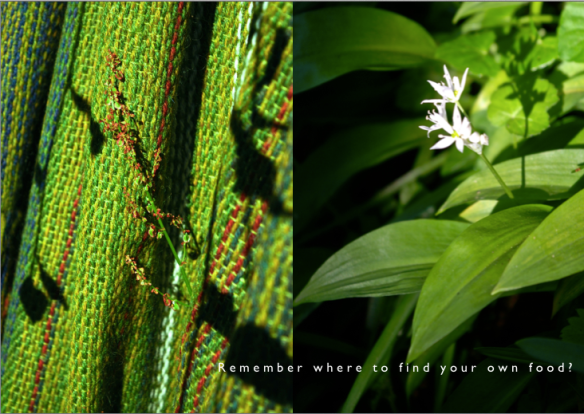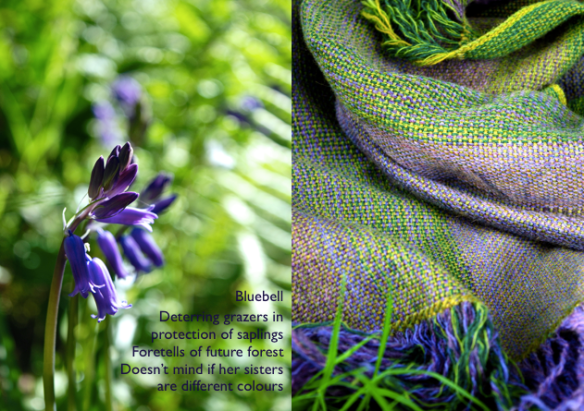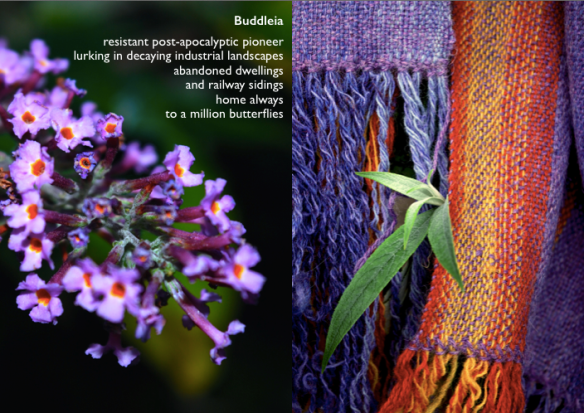So I was looking for home and love. Home keeps reconceptualising itself; love was ever thus. And now I am looking for my role in the revolution and my place in the new order. By this I mean the campaign against feudalism and the growth of something that somehow marries the best of socialism, capitalism and anarchism.
Maybe one day I’ll buy a little land, but something stops me now: not only limited choice, and not knowing where I want to settle and invest, but also concern that land ownership is such a problematic part of the old order. When one person owns, no other can be an equal on that territory, is my experience – no matter how careful, generous and skilful the parties, it seems.

I’ve been inspired by the words of a woodsman fellow weaver who made the below short film. Self-proclaimed ‘nettle nerd’ Allan Brown considers his nettle textiles a symbolic act of resistance, since wildgrowing nettles are the ‘fibre of the landless’.
Because sheep farming is tied up with land ownership, reduced bio-diversity and the meat industry, ultimately I wonder whether I should move away from wool – even the local, undyed, vegetable dyed and/or handspun wool that I prize and can ill-afford – and towards a more sustainable fibre source such as an abundant wild British plant.
At Seed eco-conference I met not only virtual friend, drop spinner and weaver Imogen Di Sapia, but also a Saori weaver, Erna Janine, freely weaving chaos principle. I have another friend, Richard Toogood, currently staying in a Neolithic reconstruction village and rough hewing his own primitive looms. Together with Allan we are cooking up ideas for a ‘Green Cloth Collective’: a Green Cloth Camp; a Green Cloth Fair; a Green Cloth Co-operative. How to make local labour viable in a globalised neoliberal world? Meantime I have some nettle yarn from Nepal out of which I’m planning a poncho. Despite that the Nepalese yarn cost me about twenty times less than if I’d spun it myself, the garment will still be pricey, alas, because of the cost of my labour at even about half the UK minimum wage. Perennial problem for craftspeople: I hate that the many cannot afford my goods. I wonder if a different world economics could alter this.
The money question. At times it’s been a relief to leave complicated barter arrangements aside and resort to the supposedly neutral tool that is currency. Like many, I have a long-held suspicion of money, but in moments like those, see its true value as a tool. I’ve never understood money markets, nor, till recently, been interested in economics at all, though now have become fascinated with the both, together and separately. Here’s why.
Contrary to what the dominant neoliberal culture would have us believe, there *is* a magic money tree, but it’s currently in the wrong hands. Money can be a common good, but the way we currently create it is not in the interests of the common good: money creation as debt forms a locking mechanism that keeps us hellbent on the impossibility of infinite growth: boom, bust, guzzle, crash. Humankind is great, but we let our shadow run the show. And the essence of our modern economic model inclines us to act more exploitatively than most of us would naturally act. *This is how it works (it’s a simplification, and it’s dry, but it’s important, so I invite you to read carefully and share widely – and of course feel free to contest).
Some fundamentals:
Firstly, apart from the tiny proportion of money that is represented by coins and notes, money is not a *thing*: money is a token, an agreement between parties, a currency that serves as a tool to be used to aid the fair exchange of actual things.
Next, a brief look at the monetary cost of *things*, that is, of goods and services:
Raw materials do not cost us money, because we do not pay money to the earth herself for the minerals and other raw materials that we extract. What we pay in money for raw materials is for the labour required to extract and process them. So the financial cost of every product or service is mostly constituted by the cost of labour, including what I will call ‘embodied labour’.
In our current monetary system, over and above the cost of labour and embodied labour, which represent the true monetary value of a thing, there’s an additional cost. On average in each monetary transaction, there is one winner and one loser, financially speaking: in order to keep afloat, the vendor must charge more for his product than the product is technically worth in terms of labour. This is because he has to pay not only the cost of labour input, but also the cost of money.
So now to explain the cost of money:
Only 3% of all money in circulation has been created by governments. The other 97% of money is debt that has been created by corporate banks who have special governmental permission to manufacture money for the purposes of lending. When a loan is agreed, the lender simply writes the money into being in their electronic ledger as they transfer it into your bank account. That’s right: they create it from thin air, as confirmed here by the Bank of England. The magic money tree is currently operated by corporate banks who commodify money, hiring it out as if it were a thing.
The borrower does not just pay a hire fee or service charge, but an exponentially growing rate according to volume and timescale: interest. As the borrower repays the loan, the money loaned is written off again by the lender: it ceases to exist. Meantime the lender has extracted surplus, in the form of interest, which far exceeds the labour costs of lending the money, and which constitutes profits for the bank’s shareholders. (Who holds the most shares and thus gains the most income from this? The richest few at the top of the pyramid.)
And back to the transaction of goods and services:
This ‘surplus’ is the additional cost that a vendor has to cover in each transaction in order to service his borrowing. Hence the consumer pays a price that is more than the true value of the actual good/service.
These individual transactions aggregate to constitute the wider economy. Because of the the moneylenders’ interest hoover, vendors charge more than the actual value of their goods and services in order to cover debt, and consumers are out of pocket. The dynamic is mathematically imbalanced: prices are higher than wages/salaries, and so wages/salaries can never cover the consumption of all the goods and services produced. This means that some vendors will make heavy losses, even while consumers everywhere borrow more and more to afford less and less. The result is an impossible quest for infinite growth: basically productivity booms as we chase the shortfall, and busts when we fail to make it. The failure is inbuilt, never-ending and relatively predictable. (So if you’ve a shrewd eye and a purse for gambling…)
Consider the human and environmental cost of all this. Most of us have our backs against the wall for at least some of the time, or are at risk of it, and fear or memory of this discomfort or strife compels us to earn harder to try and alleviate the impact of the next squeeze. Depending on our place in the hierarchy of the economic pyramid, we are either stuck on survival, running just to stand still, or, if we’re lucky/ruthless, climbing at great expense. (Perhaps even those at the very top feel they struggle financially to maintain their castles, yachts, grouse moors, oilfields.) It is hard for anyone not to feel poverty conscious. When do we have the leisure to consider the sustainability of the system, the sustainability of our households, the sustainability of our relationships, and the sustainability of our impact on the natural world?
Being debt-free as an individual does not aid the debt-based economy, since 97% of the population will necessarily be in debt (as per the current percentage of money that is debt). Keeping consumerism down does not aid the debt-based economy either: with insufficient custom, our businesses fail, and our families suffer. A debt-based economy requires consumption to be maintained at a certain level – a level that our planet cannot sustain.
Something has to change.
We reject hunting and gathering, by our land ownership, agriculture and desertification. We reject self-sufficiency, for it does not allow for specialisation. We reject communism, for it reduces us to the lowest common denominator. We contest capitalism, but even without land or property ownership, we all have capital on which to capitalise, be it time, energy, or competency. We had democratic socialism, where the welfare state looked after those in need and business gave opportunity to some. We now have neoliberalism, a barely-regulated capitalism in which voracious big business dismantles the state, looking after fewer and fewer and giving real opportunity to fewer and fewer. We rejected feudalism, but it has emerged in another guise.
Said Indian ecologist Satish Kumar of Schumacher College some years ago: ’It’s not poverty that’s the problem, but wealth.’
So what can we do about it? A pivotal measure could be the nationalisation of money creation: it could remove the locking mechanism that keeps us in wealth-hoovering, planet-devouring chains.
When things get sticky, our governments shake the magic money tree themselves and, in partnership with the central bank, perform Quantitative Easing. In other words, they print money. They can do this in any number of ways – they don’t necessarily literally print banknotes, but may create digital money to invest in particular ways with the aim of stimulating growth in a certain sector, banking on positive knock-on effects for the wider economy. It doesn’t always work, and depending on the way QE is deployed, sometimes it serves only to create yet another trickle-up mechanism to boost the already rich. But the point is this: that *governments*, the folk we elect to work for the common good, can get involved in money creation.
So what if a government took the powers of money creation largely into their own hands? President Lincoln did this successfully with ‘Greenbacks’ before he was assassinated; JFK apparently was moving in a similar direction, and other isolated economies may have done and be doing this around the world.
positivemoney.org proposes such a sovereign money system in which a friendly government works in partnership with a committee at the national bank who are independent of the governing party for the sake of neutrality. A sovereign money system would not be gameable in the way that money creation as debt is currently gameable, and should thus eliminate and/or dilute the mechanisms by which wealth is currently hoovered upwards and concentrated in the hands of a few. Sovereign money could begin to create a stable economy in which costs, wages and prices all matched. Just imagine what we’d then all be freed up to achieve if we weren’t hellbent on the myth of growth.
–:o:–
And meantime what can we as individuals do to resist, prepare and act otherwise? Here are a few suggestions.
- Visit the Positive Money website and read Bank of England literature for technical details – the more of us know what we’re talking about, the better
- Join your local Positive Money group and campaign for monetary reform
- Check out the New Economics Foundation
- Consider your own business model (bottom up? collectivist? co-operative?)
- Read Marx, Raworth, Reich, Roebottom, Monbiot and Noakes, or just interrogate bankers, economists and Positive Money folk, as I do
- Watch Bruce Parry
- Think collective, collaborative, co-operative and municipalist
- Study the economics of differently-organised countries and communities
- Support local and regional banking initiatives, including credit unions and building societies, or otherwise Triodos Bank
- Boycott
- Barter
- Share
- Discuss
- Contest
- Write letters
- Vote wisely
- Ask questions
- Gain insight
- Consider the overview
- Think in systems
- Crowd fund
- Crowd source
- Guerilla garden
- Rewild
- Recycle
- Reinvent
- Repurpose
- Upcycle
- Be vigilant
- Dream differently
- Plan carefully
- Create alternatives
- Support each other
- Remember Camus: ‘The only way to be free in an unfree world is to make your very existence an act of rebellion’
- [Please add to this list in the comments below]
*With special thanks to Chris Noakes for guiding my study of monetary reform.







